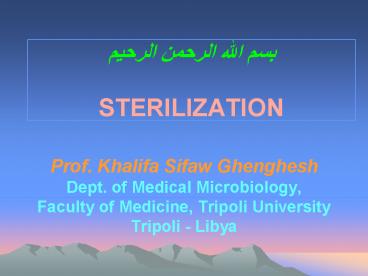??? ???? ?????? ?????? STERILIZATION - PowerPoint PPT Presentation
1 / 28
Title: ??? ???? ?????? ?????? STERILIZATION
1
??? ???? ?????? ?????? STERILIZATION
- Prof. Khalifa Sifaw Ghenghesh
- Dept. of Medical Microbiology,
- Faculty of Medicine, Tripoli University
- Tripoli - Libya
2
What is Sterilization?
- The removal of all forms of living material.
- Important First Objects to Be Sterilized Should
Be Cleaned by Washing.
3
METHODS OF STERILIZATION
- 1. DRY HEAT
- Red Heat
- Hot - Air Oven
- 160o/ 60 minutes
- 180o/ 20 minutes
- 2. MOIST HEAT
- Tyndallization gt 100oC/ 30 minutes On 3
Consecutive Days. - The Autoclave gt Pressurized Steam.
- 121oC/ 1.1 bar for 15 minutes.
- 134oC/ 2.2 bar for 3 minutes.
4
(No Transcript)
5
(No Transcript)
6
- TESTS FOR AUTOCLAVE FUNCTION
- The Bowie-Dick Autoclave Tape Test
- Browne's Tubes
- Automatic Controls or Pen Records
- Bacteriological Tests (Spore Tests)
7
- 2. IRRADIATION
- i. Ultra - Violet Radiation (UV)
- a. Not Recommended.
- b. Poor penetration in Air.
- c. Suitable to Reduce Microbial Counts
- in Safety Cabinets.
- ii. Gamma - Ray Radiation
- Source Cobalt 60.
- a. Lethal to All Forms of Microbial
- Life.
- b. Used Commercially.
8
- 3. FILTRATION
- Bacterial Stopping Filters.
- 4. GASES
- i. Ethylene Oxide Gas
- a. Ventilators.
- b. Toxic Explodes When Mixed with Air.
- ii. Formaldehyde
- a. Rooms and Lab. Cabinets.
9
- 5. LIQUIDES
- Disinfectants.
- i. Glutaraldehyde
- a. Sterilizing Heat Sensitive Pieces of
Equipments.
10
- Forms of Sterilization by Heat and Principle
Uses. - __________________________________________________
_____________ - Type of Heat Use
- __________________________________________________
_____________ - DRY
- 1. Red Heat. Microbiological Loops.
Incineration of Used - Lab. Culture Plates.
- 2. Hot - Air Oven. Many Surgical Dental
Instruments but Not Fabrics or Rubber. - --------------------------------------------------
--------------------------------------------------
------ - MOIST
- 1. Steam at 100oC Some Bacteriological Media.
- On 3 Consecutive Days.
- 2. Pressurized Most Surgical and Dental
Instruments, - Steam (Autoclave). Fabrics Dressings (If
Wrapped) Most Microbiological Media
Glassware. - __________________________________________________
_____________
11
- Heat Content of Water and Steam
- _______________________________________
- Phase Temp. Heat Content (kJ/kg)
- of oC Sensible Latent Total
- Water Heat Heat Heat
- --------------------------------------------------
--------------- - Liquid 100 419 0 419
- Vapour 100 419 2257 2676
- Vapour 121 509 2199 2708
- Vapour 135 567 2160 2727
- _______________________________________
12
- PROPERTIES OF STEAM
- i. Moisture content
- ii. Heat content
- iii. Penetration
13
- PRESSURE STEAM STERILIZERS
- 1. Porous Load Sterilizers (Prevacuum type)
- Removal of air and heating of the chamber.
- Sterilization of the load.
- Removal of steam and drying of the load by
mechanical evacuation. - Admission of filtered air to restoration
atmospheric pressure.
14
- 2. Downward Displacement Jacketed
- Sterilizers
- Gradual displacement of air by incoming steam
while the chamber is heated to the selected
sterilizing temp. - Sterilization of the textile packs for
- 30 min/ 121oc.
- Drying of the load by partial vacuum.
- Restoration of the chamber to
- atmospheric pressure.
15
- 3. Unwrapped Instrument and Utensil
- Sterilizers
- DSL autoclaves
- 4. Fluid Sterilizers
- e.g. water, iv solutions, etc.
16
- Factors influencing sterilization time for
fluids - rate of heating of the chamber
- type of container
- viscosity of the liquid
- volume of the liquid
- trapped air
17
"??? ???? ?????? ??????" DISINFECTION AND
DISINFECTANTS
- Prof. Khalifa Sifaw Ghenghesh
- Dept. of Medical Microbiology,
- Faculty of Medicine, Al-Fateh University
- Tripoli - Libya
18
Disinfection
- The removal of most of the pathogenic
microorganism, but often non-pathogenic or
resistant forms of pathogens remain.
19
Methods of Disinfection
- A. Cleaning
- Instruments with high risk organic material gtgt
- Treat with strong disinfectant gtgt Cleaning gtgt
Sterile or dispose of.
20
- B. Disinfection by Heat
- i. Pasteurization
- ii. Boiling water
- iii. Flaming off alcohol
- C. Physical Methods
- Ultrasonics
- Ultrasonic vibration gt
- Disrupte microorganisms
- e.g. Ultrasonic scalers.
21
- D. Chemical Disinfectants
- Denaturing protein or lipid
- Act Disrupting the biosynthetic pathways
- I. Phenols
- Clear phenolic solutions
- Black and White Phenolic Compounds
- Chloroxylenol (Dettol)
- Hexachlorophane Pre-operative scrub
22
- II. Halogenic Compounds
- Hypochlorites Effective gt HBV
- Iodine Alcohol
- Pre-operative skin antiseptic.
- Bovidone Iodine
- an anti-plaque agent.
23
- III. Aldehydes
- Formaldehyde
- Gluteraldehyde
- Alcohol
- -----------------------
- Antiseptics
- Are bacteriostatic agents that can be used on
skin and mucosal surfaces.
24
- IV. Diguanides
- Chlorhexdine
- 0.5 70 alcohol gtgtgt Skin
-
disinfectant - Chlorhexidine gluconate
- Treatment of oral candidosis oral
-
ulceration
25
- V. Quaternary Ammonium Compounds
- Cetrimide
- VI. Organic Dyes
- e.g. gentian violet
26
- Factors Affecting the Effectiveness of
Disinfectants - Tests of the Proper Functioning of Liquid
Disinfectants - " In-use" Tests.
27
- Storage of Sterile Instruments
- Never store instruments in liquid disinfectants.
- Waste Disposal
- Special Problems
- HBV, HCV and HIV (AIDS)
28
- Sterilization and Disinfection
- in Dentistry
- Sterilization gtgtgt Autoclave.
- Dental instruments can and should be
- autoclaved after each patient.
- Nozzles of air and water spray ??

